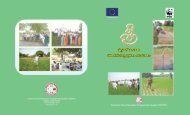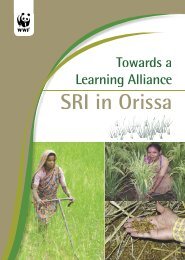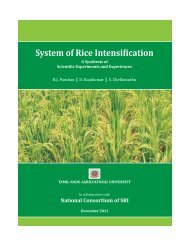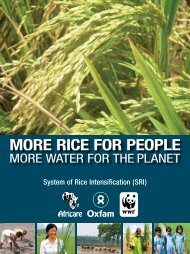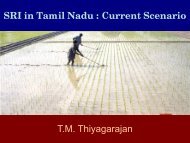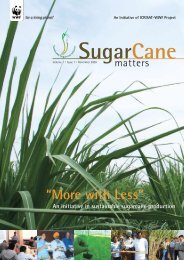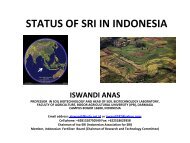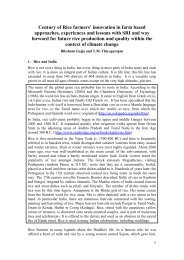Sustainable Sugarcane Initiative (SSI) manual - SRI - India
Sustainable Sugarcane Initiative (SSI) manual - SRI - India
Sustainable Sugarcane Initiative (SSI) manual - SRI - India
Create successful ePaper yourself
Turn your PDF publications into a flip-book with our unique Google optimized e-Paper software.
Foreword<br />
Water is increasingly becoming a major limiting factor for agriculture, especially where irrigated crops<br />
and dry land agriculture are intermixed. Often in the same watershed, both irrigated crops such as<br />
rice and sugarcane exist with dry land crops such as sorghum and millets. In such circumstances, the<br />
impact of irrigated crops on dry land agriculture is significant, particularly in semi-arid regions, where<br />
irrigation is primarily based on ground water exploitation, leading to decline in soil moisture and<br />
seriously reducing the productivity. Further, the erratic trends in rainfall add to the growing complexity<br />
of the water issues. Thus, we need to explore every possible approach to reduce the water input to all<br />
crops, particularly those which excessively depend on scarce resources. Any water reduction to thirsty<br />
crops such as sugarcane will have a positive impact on the dry land agriculture in the same region.<br />
To improve productivity and protect the ecosystem, an integrated approach to agriculture involving<br />
all stakeholders is essential in tackling pressing issues such as the decline in productivity, ground<br />
water table, soil moisture and the uncertainty of monsoons, all of which are interlinked. On one<br />
hand, watershed management can improve the water resources in basins, but on the other hand,<br />
until and unless that water is used more productively, the investments will not yield results.<br />
In order to understand and address the water issues in a holistic way, the International Crops Research<br />
Institute for the Semi-Arid Tropics (ICRISAT) entered into a partnership with the World Wide Fund for<br />
Nature (WWF). The joint project on ‘Improving the water productivity of the agriculture’ is researching<br />
non-traditional and out-of-the-box approaches wherein the resource inputs are low and yields are<br />
high. The <strong>Sustainable</strong> <strong>Sugarcane</strong> <strong>Initiative</strong> (<strong>SSI</strong>) is one such approach that could reduce the inputs -<br />
water, fertilizer, seed material - while improving sugarcane production significantly. This farm-based<br />
approach gives farmers options to grow intercrops such as pulses to improve their income, while<br />
effectively using the soil moisture to grow dry land crops. This <strong>manual</strong> describes, step-wise, how to<br />
put <strong>SSI</strong> in to practice. It has been developed following extensive consultations with farmers and is<br />
very user friendly. It will be translated soon into several <strong>India</strong>n languages so that farmers can use<br />
and benefit from this new method.<br />
I am delighted that the ICRISAT-WWF partnership is working on solutions to address the water crisis<br />
without compromising on agricultural production. The WWF, with its main mandate of protecting<br />
the ecosystems, is working with a vision that the methods like <strong>SSI</strong> will help in producing more while<br />
reducing the ecological foot print of agriculture. Similarly, ICRISAT is collaborating with WWF to<br />
understand and integrate the ecological concerns of agriculture. This partnership is unique and we<br />
are looking forward to many more practical results on the ground. This <strong>manual</strong> is one such attempt.<br />
I do hope farmers and researchers will be able to use it effectively to address the pressing issues of<br />
sugarcane production in general and the water crisis in particular.<br />
William D. Dar<br />
Director General<br />
ICRISAT<br />
Improving <strong>Sugarcane</strong> Cultivation in <strong>India</strong> 3



